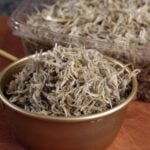If I run out of any of these, I feel uncomfortable. The good thing about most of them is that you can store them for a long time in the fridge or freezer. I don’t always keep extras of all of these ingredients at all times, but I always buy more when they run out.
Dried anchovies (myeolchi)
Dried anchovies are used in stews, stocks, and some side dishes. They are essential for making ddeokbokki, baechu doenjangguk, and doenjangjjigae. Stores usually sell 3 types of dried anchovies, based on the size of the anchovy: large, medium, and small.
The large size (between 2½ to 3 inches long) is usually used to make stock. Medium (between 1½ to 2 inches) sized anchovies are eaten as a side dish. The smallest size, less than ½ inches, can be eaten as a side dish, too.
Store in the freezer.
See all recipes that use myeolchi
Seaweed paper (kim)
Kim is very handy: you can make gimbap with it, or roast and crush it to use as a garnish for your stir-fried rice, bibimbap, or rice cake soup.
Having kim in the freezer means I can make a nutritious, fast, delicious meal anytime in the form of a quick roll. I just roast a sheet of paper and then roll up some rice and maybe add some chopped kimchi to it. It’s the Korean equivalent of a sandwich.
Store in the freezer.
Dried shiitake mushrooms (pyogobeoseot)
These mushrooms usually need to be first prepared by soaking them in cold or warm water until they’re soft. Then you can make a simple, all-purpose, delicious Korean stock from them by boiling with dried anchovies, dried kelp, water, onion, and radish.
Dried shiitake mushrooms are also a very important ingredient in japchae, and they can be used as a vegetarian substitute for pork or beef.
Store in the pantry or freezer.
See all recipes that use shiitake mushrooms
Thin noodles (somyeon)
These thin noodles are used in some classic Korean dishes. One of my favorites is bibimguksu, which can be prepared for a quick lunch by mixing cooked noodles with chopped kimchi, hot pepper paste, garlic, sugar, and toasted sesame oil. Simple and delicious.
Store in a cool, dry place.
See all recipes that use these noodles
Radish or daikon (mu)
I use mu all the time to make kimchi, in soups like bugeoguk, and stocks.
Store in your fridge crisper, wrapped in a newspaper and a plastic bag. It should last for 2 weeks. Longer than that and it will wither and become spongelike.
See all recipes that use Korean radish
Sweet rice flour (chapssalgaru)
With this flour I can make Korean style mochi (chapssaltteok), sesame seed porridge, or injeolmi in 10 minutes. I also use it when I make paste for kimchi, and adding it to the batter of a pancake will make it crispy and a little chewy.
I use Mochiko brand, which is conveniently packaged in a box, not a bag. This flour is sometimes known as “glutinous rice flour” (it doesn’t have gluten, it just means it’s sticky like glue), “glutinous rice powder”, “sweet glutinous rice flour” or even “mochi flour.”



























